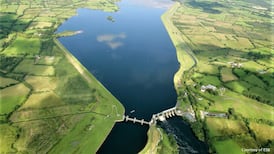One morning last August, Seamus O’Neill was fishing on the Derryinver Bridge pool, which spans the Dowras river near Letterfrack, Co Galway. He quickly landed his first salmon, but looking at the fish he realised something wasn’t right. Its tail and dorsal fin were torn and ragged with what appeared to be bite marks, and its head was noticeably small. Seamus rang his local fisheries inspectorate and asked them to send someone down.
Fisheries officers were already on high alert. Just a few days earlier, a major incident had unfolded in nearby Killary Harbour at the Mannin Bay Organic Salmon’s farm, where tens of thousands of fish are kept in circular cages at sea for up to two years before being processed and sold. A well-boat had travelled out to the cages to bathe the fish with fresh water to deal with a parasitic gill disease, which flourishes in warmer waters. The weather was inclement, and a net on one of the cages tore. Up to 8,000 farmed fish poured out and escaped into the wild.
Seamus O’Neill’s fish was killed and taken to the lab. Salmon scales grow in concentric rings, a bit like tree rings. This gives clues to the fish’s life history, including whether it’s wild or farmed. The salmon was examined and the results were conclusive: it was a farmed salmon. Within days, anglers across Mayo and Galway reported farmed salmon in Ireland’s most pristine wild salmon rivers.
By law, salmon farm operators are mandated to report fish farm escapes to Inland Fisheries Ireland within 24 hours; according to the IFI, that didn’t happen in this case. In a report on the Killary escape published last month, the IFI concluded that the farmed salmon dispersed into wild salmon rivers in “significant numbers”, including sexually mature males capable of interbreeding with wild salmon.
This ‘Irish Whale’ has been spotted off Donegal and the coast of North America
Let’s be ambitious for a plan to establish a real record of the majestic Shannon’s condition
An extraordinary find in the Irish Sea left experts gobsmacked
The golden plover’s numbers in Ireland have dwindled to a few isolated strongholds
Captive, controlled and fed on processed feed by humans, farmed fish are artificially bred for rapid growth and come from a genetic lineage different from wild salmon. Farmed salmon interbred with wild salmon produce offspring less adapted to nature and with lower survival rates; too many farmed salmon in the wild decrease the overall productivity of the population.
Nearly all of the world’s salmon farming involves open-net pens placed in fjords, bays and sheltered waters like Killary. Seawater flows freely between the porous cages and the surrounding environment. However, as the industry continues to expand to meet global demand, problems with open-net pens keep arising.
Tiny parasites that burrow into and feed off the skin and blood of salmon infest the cages. These sea lice can float 100km away, infecting wild salmon and sea trout as they swim by. Food and faeces fall through the cages and damage the surrounding environment. Antibiotics and other medical treatments are used. Meanwhile, rising water temperatures and increasingly powerful storms bring even more risk to bear. And it’s bad for business: output in 2023 fell by nearly a quarter, mainly because of environmental conditions.
In Norway, the world’s largest producer of farmed salmon, the wild salmon population has dropped by half in the past 30 years and problems from salmon farming are the greatest threats. An estimated 200,000 farmed fish escape every year, and scientists say that if wild salmon are to survive, the industry must move to closed containment systems. The Canadian government has announced a ban on open-net pen salmon farming in coastal waters as a commitment to “protecting wild salmon”.
The salmon industry has long argued that moving farming on land or into closed containment systems would be too expensive. (In 2023, the world’s largest salmon farm company, Mowi – which operates in Ireland – reported profits of €1 billion.) But one young Norwegian fish farmer has taken on the challenge of developing a closed system.
Sondre Eide, chief executive of his family-owned company, created the “Watermoon”, an enclosed cylindrical tank that is submerged 72m into the water and holds 200,000 fish in a closed-loop system. Seawater circulates through the tank, but fish faeces and waste are filtered and taken away to generate biogas. Because the farmed salmon are kept inside the tank, the sea lice are kept out and the fish cannot escape into the wild. Last month, after piloting his first Watermoon, Eide announced his company will have four more in the sea by the end of the year.
Closed containment is no panacea. It’s expensive – the Watermoon cost hundreds of millions of kroner (€1 = 11.7 kroner) to develop – and it’s unclear, over time, what unforeseen complications might arise from a closed system of intensive fish farming. Nature is more complex than we can imagine. But it solves the serious problems threatening our wild salmon: sea lice, escapees and nutrient and chemical pollution. Fish farmers such as Eide, willing to take financial risks to find solutions, need governments to pressure the industry to transition away from open-net pens and invest in alternatives.
Salmon have been farmed in Irish waters since the 1980s, when Tony Fox, the son of a Tallaght farmer, left his job as a teacher and received backing from Norwegian investors to set up a fish farm off Donegal. Today the farmed salmon sector employs 180 people full-time across five companies. Ireland is the largest producer of farmed salmon in the EU, and all of it is in open-net pens off our Atlantic coast.
The Killary incident, just one of many in the previous few decades, reveals a system with too much risk. In the past two decades, wild salmon numbers in Ireland have slumped by 80 per cent. If we hope to reverse the numbers – to ensure that for future generations, wild salmon is their reality, not just a memory – then urgent action is needed.
















